CUBA
AIRGUIDE
Tourist Magazine
March 1956
[NOTE:
1. Page numbers begin with
the cover.
2. The following is broken
into page numbers with links to the advertisements and
photographs on each page.
3. This publication had
many typographical errors, which only a few were corrected
4. Corrections follow the
error in brackets.]
Page 1
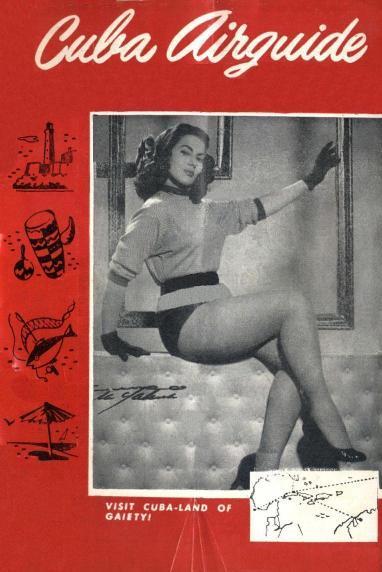 CUBA AIRGUIDE .. [Cover] [To
see a full size photo, right click and VIEW IMAGE]
CUBA AIRGUIDE .. [Cover] [To
see a full size photo, right click and VIEW IMAGE]
Visit Cuba-Land of Gaiety!
Page 2
Hotel Vedado advertisement
page 3
CUBA AIRGUIDE
Vol. 3, MARCH, 1956 No. 3
Publisher: MIGUEL M. FOX
CONTENTS:
Havana Sketches.................5
Visit the Isle of Pines.........12
The Havana Zoo................19
Havana by Night................23
Tourist Supplement............35
[To see a full size photo,
right click and VIEW IMAGE]
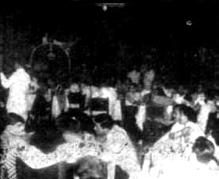 [people dining]
[people dining]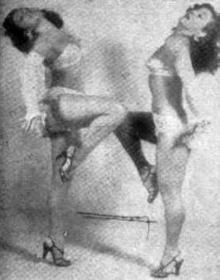 [two chorus girls]
[two chorus girls]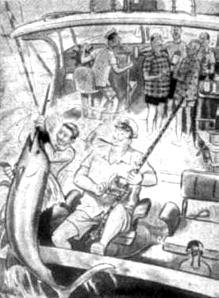 [drawing of men fishing]
[drawing of men fishing]
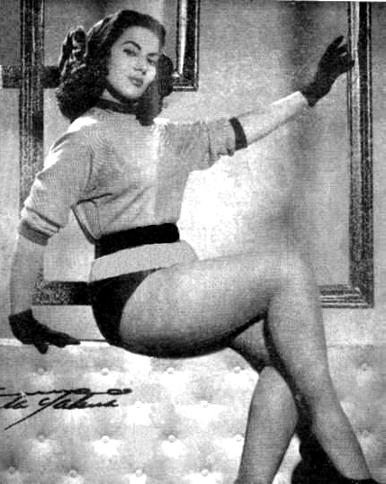
[To see a full size photo, right click and VIEW IMAGE]
OUR COVER
Marta Veliz, Vedette
Published monthly by "Organizacion de Revistas y
Publicaciones
Asociadas". Editorial and advertising offices: Avenida
7A No. 663
ent. Ave. de los Oficiales y Calle 1, Buenavista, Marianao,
Havana,
Cuba. Telephone: B-8951. Entered as Second Class
Matter at
the Post Office at Havana, Cuba. Price per copy:
$0.15/
Subscription: $1.50 per year.
THIS IS AN O.R.P.A. PUBLICATION
Page 4
El Encanto Ad
Page 5
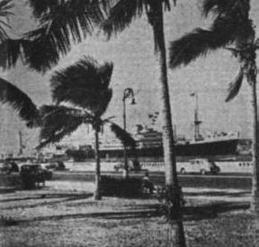 -- [no caption -- Ship entering
harbor]
-- [no caption -- Ship entering
harbor]
HAVANA SKETCHES
AT first, we had thought about adding on a fictitious ending
and making
a story about of it, but finally we decided to pass it on
just as we
heard it. We were at an art gallery in the Cathedral
Square,
where there is a certain sea-scape that we yearn for, and
will some
day–but that is quite a different story. Anyway, we
were at this
art gallery, and as is not uncommon, the talk had swung to
topics
distantly, if at all, related to art. As a matter of
fact, it was
about witchcraft and allied topics that the Uruguayan
painter, the
Havana pharmacologist and ourselves were talking. The
painter had
just told us about the time in Brazil that a painting of
his, on native
cult motifs, almost became an object of veneration by some
natives who
saw it through an open window; and the pharmacologist smiled
and told
us his story:
"My wife," he began, "has a silver jewel case that I gave
her when we
were engaged. It's a beautiful piece of filigree work,
and worth
a lot more than what I paid for it, which was $78. She
never
heard about how I raised the money for it until well after
we were
married, though: I didn't want to have her get a bad
impression,
especially since at that time what I most wanted was to
impress her
favorably. Young love, you know.
"Anyway, this is how I got the money: On my way to classes
at the
University, I used to take a short-cut through the Quinta de
los
Molinos, the University of Havana's experimental farm.
One day I
saw three cents, three copper pennies, lying on the
path.
Naturally, I picked them up and put them in my pocket.
The next
day, once again there were the three coins on the path;
three more
copper pennies, I mean. Again, I picked them up and
pocketed
them, but this time I mentioned the matter to one of my
classmates,
saying that it was certainly an unusual coincidence.
"My classmate laughed, and asked me if I really didn't know
what the
coins meant. When he saw that I didn't, he told me
that it was
part of the Ñañigo rite to make an offering of three
copper coins to one of the rite's deities, and that I had,
in effect,
been plundering an altar, since the path obviously had some
religious
aura attached; at least, since the Quinta de los Molinos is
the only
large tract of wooded land left in the heart of Havana, that
was what
seemed most likely, that it was the scene of some Ñañigo
rites. He added that if I were
Page 6
Bacardi advertisement
superstitious (not that he was, of course) perhaps I should
leave the coins right there.
I didn't take his advice. Instead, I took the three
cents every
day. Or rather, I took the three cents every time I
found them;
for some days I would find them not only I the morning on my
way to
classes, but also in the afternoon, and sometimes, on one of
the big
Ñañigo feasts, I suppose, I would find several offerings,
each one consisting of the inevitable three coins.
Well, time
went by, and after a while, the box I kept the coins in (for
I never
spent them, but just kept chucking them into a box with no
fixed
purpose in mind) was a comfortably full. Then one day
I
remembered that my fiancee's saint's-day was coming up, and
went out
shopping for a present for her. I saw the jewel case
in a shop
window, liked it and bought it. I don't think the
jeweler had
ever seen so many pennies in his life.
"After we were married I told my wife the story, but it
didn't seem to
worry her. Every now and then, though, when she speaks
about the
case, she calls it her witch-case."
That was all there was to the story, he insisted in spite of
our pleas
for a dramatic ending. As we said before, we had
though of adding
an ending to the story, something about their house being
broken into
on the eve of some big cult festival, and only the box being
taken,
with three copper cents being left in its place, but on
thinking it
over, we decided to leave it as he told it. Not only
is it true
it seems to make a better story that way too.
Page 7
Tasca advertisement
One of the minor mysteries of life in Havana had just been
solved for
us, and we pass the solution on to you, in case you were
ever puzzled
by the same thing as we were. Every now and then,
passing by
certain shops or office buildings downtown, the steady
ringing of a
bell caught out attention. It never intrigued us too
much, and we
were content to make up spur-of-the-moment explanations
(burglar-alarms, short-circuits in the phone system, calls
for
messenger boys, private telegraph systems were some of the
less
fanciful ones) and let it go at that. Recently,
however, we began
to hear the bell ringing near the spot where a friend has
his office,
and we asked him about it. Did he know what it
meant?
Certainly; hadn't we noticed that wherever the bell was to
be heard,
there was always a coffee stand close by? Well,
what the
bell meant was simply that a fresh batch of coffee was being
brewed. So if you ever are downtown and hear what
sounds like a
stuck telephone, just step right up and invest three cents
(there's
that phrase again) in a delicious cup of pipping hot café
solo.
The other day, in the elevator going up to our office our
attention was
attracted by two girls, one a doctor, who were animatedly
speaking to
each other in fluent French. At least one of them was
a Cuban: a
Spanish phrase she used was much too colloquial to have been
used by a
foreigner. Intrigued, we started doing some checking
up on the
subject of languages in Havana. Well, to begin with,
at least
Page 8
Grant's Whisky advertisement
two radio stations do most of their transmitting in English;
there are
radio programs in Arabic, Yiddish and Chinese to be heard
daily.
Newspapers are published in English, Chinese and Yiddish,
and several
magazines come out in the various Spanish regional
dialects. But
probably the most typical sign of Havana's polyglottism is
to be seen
in hundreds of local shops and establishments: grocery,
beauty shop,
insurance company, and dozens of others are not exactly
Spanish.
So far, no tea shoppe, though.
From the Havana Post: "Beautiful room with lavatory, will
rent to
American gentleman, very cool." As the New Yorker
might say, only
hep-cats need apply?
It would sem that the tourist trade is one of Havana's
oldest
businesses. According to a recently published article,
among the
fifty persons or so who made up Havana's population when it
was founded
in 1514, fourteen were temporary visitors. To equal
that
proportion nowadays, there would have to be some 250,000
tourists in
Havana at any given time.
What does one eat in Havana? (We shall pay no
attention to those
of our friends who claim that we subsist almost exclusively
on a diet
of hamburgers and coffee: we haven't had a hamburger in two
months). Most visitors to Havana stick pretty much to
the
standard standby of steak and potatoes, with occasional
excursions into
the field of seafood, especially Morro crabs. This is
a pity, for
Havana restaurants feature dozens of dishes
Page 9
Club 21 advertisement
which are both typical and delicious. What would we
suggest as a
typical Havana-style meal? Well, there's always arroz
con pollo
and arroz con mariscos (rice with chicken and rice with
seafood) and
lechon asado, roast suckling pig, but these are individual
dishes
rather than complete meals, which are what we're interested
in. A
quick survey taken among our friends has resulted in a
unanimous
difference of opinion: not two agreed on the same meal, but
from the
various suggestions they made we have presumed to extract
two menus
which are about as typical as anything you can get in
Havana, and can
be gotten at just about every restaurant in town, except,
possibly the
swankier ones, which are apt to find them perhaps a trifle
too
common. Common they may be: delicious they certainly
are.
Menu one starts off with ajiaco, a thick vegetable soup that
has in
virtually every edible plant and tuber in Cuba; pumpkin,
tomato, yam,
sweet potato, and anything else that may be at hand, plus
beef, salt
pork and sundry other seasonings; in short, a sort of
vegetable
chowder. It may be eaten straight, like soup, or you
can add
plain white rice to it and eat it as a kind of stew; almost
invariably,
however, it is served with the crisp French-style bread
known locally
as pan de flauta–no butter. Next would come congri,
which is rice
cooked with black or red beans, eaten with picadillo a la
criolla,
which translates out as mincemeat native style, but which
tastes
something out of this world, due to the seasoning it
contains.
(Note: Cuban food is always highly seasoned, but very
seldom, if ever,
hot. The
Page10
Johnny's Dream Club advertisement
seasoning used are relatively mild, to heighten the taste of
the food,
not disguise it by burning your tongue into uselessness:
thyme, garlic,
oregano, saffron, bay-leaves, are some of the commoner
ones). As
a side dish, fried green plantains, which, in the very
unlikely event
of your not being familiar with them, are something like
oversized
bananas, but never eaten raw, being used instead for boiling
or frying,
whether–green or ripe. A simple lettuce, tomato and
cucumber
salad, made with salt, vinegar and olive oil, rounds out the
meal. In this menu, two Spanish bean stew, loaded
heavily with
pork and Spanish sausage, might be substituted for the
ajiaco; their
names are fabada asturiana and caldo gallego. Menu
two, and
excellent Lenten meal, would begin with a black bean stew,
made without
any meat at all, though you'd never guess it from the taste,
and which
is often eaten with rice, and a little olive oil thrown in
for extra
flavor. Next would come a parguito frito, a little
fried snapper,
or a breaded filet of snapper, or a rueda or slice of
sailfish, snapper
or grouper, eaten with fried potatoes or green
plantains. To
accompany either of these meals, cold Cuban beer (wine, in
Cuba, is for
arroz con pollo, or lechon asado, at Christmas; it is seldom
drunk at
mealtimes otherwise) and for desert, of course, cream cheese
with guava
sections (cascos de guayaba) or preserved orange or
grapefruit
sections. Finish off with a cup of café solo, the
strong
black coffee which makes the American demitassee [demitasse]
about as
strong as watered coke in comparison.
These were but two of the dozens of combinations that could
have been suggested here; we chose them as be-
page 11
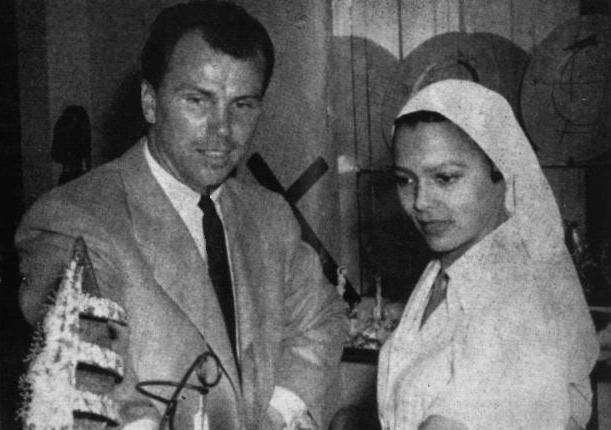 [To see a full
size photo, right click and VIEW IMAGE]
Dorthy [Dorothy] Dandridge visiting the Cuban Art Center,
the
famous movie star and singer is being attended by the
Director of the
Cuban Art Center, Sepy Dobronyi, famous jeweler and
artist. ~ The Cuban
Art Center was inaugurated only a few weeks ago with
tremendous success
and has gained the admiration of the visiting American
[American]
public.
Cuban Art Center advertisement
[To see a full
size photo, right click and VIEW IMAGE]
Dorthy [Dorothy] Dandridge visiting the Cuban Art Center,
the
famous movie star and singer is being attended by the
Director of the
Cuban Art Center, Sepy Dobronyi, famous jeweler and
artist. ~ The Cuban
Art Center was inaugurated only a few weeks ago with
tremendous success
and has gained the admiration of the visiting American
[American]
public.
Cuban Art Center advertisement
ing typical of the meals that ten thousand Cubans eat every
day in
hundreds of restaurants in Havana. Anyone wanting to
learn some
more can invite us to lunch: we'll be glad to give him all
the other
menus he wants. Just one thing though: no seafood for
this
writer. We break out in spots and itch all over if we
have to eat
it. However we have no objection to your eating it
while we eat
something more to our liking. Steak and fried
potatoes, say.
Everyone knows, we suppose, that in 1762, after a two
month's siege,
the English took Havana and remained in possession of the
Capital for
almost a year, until the Treaty of Paris returned Cuba to
Spanish
control in 1763. But few people realize that in
exchange for the
return of Havana, Span ceded he whole of Florida to
England.
Thinking it over carefully, that's what we call a proper
sense of
values (Knock, knock).
Page 12
FOR A DIFFERENT
HOLIDAY
VISIT THE ISLE
OF PINES
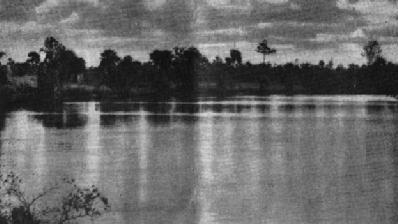 – Scene near Nueva Gerona
– Scene near Nueva Gerona
NO theaters, no nightclubs, less taxis–all this adds up to
an than half a dozen hotels, few ideal vacation on the Isle
of Pines.
This small island off he southern coast of Havana is
one of the
loveliest spots in the Caribbean, and in spite of being so
easy to get
to, it is almost unknown except by name, even to the
inhabitants of
Cuba, to which it belongs.
About seventy miles off-shore, the small island has had a
chequered
history. Discovered by Columbus himself on his second
voyage in
1494, and named the Isle of the Evangelist by him, Isle of
Pines was
virtually abandoned for centuries, inhabited only by a few
Indians and
an occasional Spancipal pirate centers of the whole
Caribbean, until
the Spanish and British finally succeeded in stamping out
piracy in the
West Indies. The Isle of Pines then sank once again
into relative
oblivion, until the past century, when its many marble
quarries began
to be worked extensively, and many farms were established
there.
After Cuba's successful War of Independence ended in 1898,
the Isle of
Pines was not included in the Treaty of Paris, which
confirmed Cuba's
sovereignty, as part of the naish garrison. But in the
Seventeenth Century, farsighted pirates realized that it
would make an
ideal base for their operations, and for many, many years
the island
was one of the prin-
Page 13
Floridita advertisement
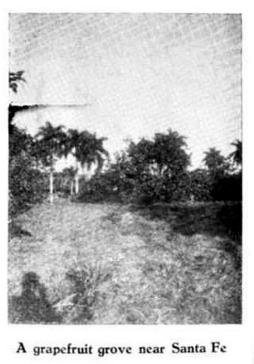
[To see a full size photo, right click and VIEW IMAGE]
– A grapefruit grove near
Santa Fe
tional territory, and it was generally believed that it
would go to the
United States. Hundreds of American settlers moved
down, lured by
the glowing advertisements which painted the island as a
tropical
paradise. And for once the advertisements did not lie:
the island
was all that had been promised. Farms and citrus
plantations were
started, and the island prospered as exports mounted.
But in 1925
the Hay-Quesada Treaty between the U. S. and Cuba recognized
Cuba's
right to the Island, and most of the American settlers
returned to the
States, leaving behind a handful of ghost towns, which had
existed only
a couple of decades. Once more the Isle of Pines
became almost
forgotten, its few thousand inhabitants virtually isolated
from their
fellow citizens on the mainland. By this time the
California and
Florida citrus boom had made the importation of grapefruit
and oranges
from the Isle of Pines unprofitable. During the war, a
lot of
low-grade iron ore, which abounds on the island, was shipped
out, but
that, too, ceased, with the end of hostilities. Piles
of the ore
may still be seen on the wharves at Nueva Gerona where it
was dumped to
await transport north.
But recently Isle of Pines has been stirring again. Citrus
is being
exported once more, and truck farming is becoming a big
business, with
tons of cucumbers and other vegetables being flown out daily
to Florida
markets. Cattle raising is on the increase, and there
are rumors
that the swampy mid-isle section is going to be used for
large scale
rice growing. There are other rumors going about too,
rumors that
have stirred up a lot of
Page 14
Banana Cordial advertisement
interest in local and foreign circles: reports of the
existence of
radioactive minerals, and what is more likely, the therefore
more
important, of large tungsten deposits.
It is, however, in the tourist field that the greatest signs
of a new
life for the Isle of Pines are to be seen. Many Cubans
from the
mainland are building homes here, and it is generally
believed that
hotels and motels will be next under construction. On
the
southern coast, beyond the swampy central section, a
Cuban-American
combine is said to have bought several hundred acres
of land and
beach where they intend to develop a tourist resort that
will rival
Varadero. The Cuban government has authorized the
holding of
bullfights on the island, and various local promoters are
actively
interested in this. More and more Cubans and
foreigners are
finding out for themselves that the medicinal waters of the
island's
many thermal and mineral springs possess remarkable
therapeutic
properties, and even more are discovering what certain
sportsmen have
known for many years: that for a different, thoroughly
restful
vacation, there's no place like the Isle of Pines.
True, there's no nightlife, no bright lights, few
shops. But there are many
Page 15
Fin de Siglo advertisement
Map Isla de Pinos
other things that make up overwhelmingly for the absence of
these
things, which after all are to be found, on a large scale, a
few miles
away in Havana.
What is there to attract the visitor to the Island? Well, to
begin
with, there's some of the loveliest scenery in all of Cuba,
there. Next–and this is highly important in these days
of tension
torn nerves and nervous breakdowns for all–it is one of the
quietest,
most peaceful spots on earth. Does this mean that it
is a dull
boring place? Well, yes, it does–if you absolutely
must have a
nightclub, and the clamorous noises of a city in order to be
entertained. But most people find that there is more
than enough
to do on the island.
To begin with, there's the traditional tourist pastime,
sightseeing. The Model Prison, one of the most
up-to-date penal
establishments in the world, attracts a lot of visitors, who
almost
invariably leave it loaded down with samples of the inmates'
excellent
handicrafts. Then there are the citrus plantations,
Jones Jungle,
one of the outstanding tropical botanical collections
anywhere, the
marble quarries, the deserted towns in the hinterland,
Page 16
[To see a full size photo,
right click and VIEW IMAGE]
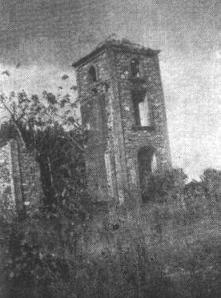 – An abandoned church on the island
– An abandoned church on the island 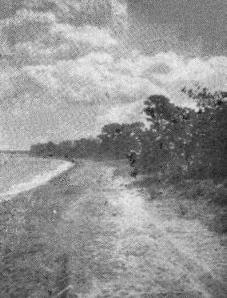 – Bibijagua Beach
– Bibijagua Beach
or, if you just like to roam, there are horses and cars
available so that you can cover the island to your hart's
content.
Hunting is quite good on the Isle of Pines: quail, doves,
duck,
pheasant and some wild pig are to be found there. The
fishing is,
to put it mildly, very mildly, fabulous. Perhaps one
of the
reasons that the island is not be better known, it has been
suggested,
is that for years the principal visitors there were
fanatical fishermen
who were in no hurry to let others in on the secret of their
rich new
fishing grounds. Boats are available on the island,
fully
equipped for everything from a couple of hours of looking
for snapper
to a week's trip fishing for sharks or sailfish or what have
you; and
rare is the fisherman who disembarks empty-handed from one
of these
trips. If you are a swimming fan, the island abounds
in lovely
beaches, including one, Playa Bibijagua, whose sand is
black.
Yes, we know it sounds funny: who ever heard of black sand
at a
beach? But the fact remains that the sand at Playa
Bibijagua is,
not brown, not gray, but black.
Accommodations? Ample and comfortable. Nueva
Gerona, the
capital of the Island, has two hotels; the Isla de Pinos and
the
Virginia; a few miles out of town there is guest house, the
Rancho
Rockyford, which is open from November through May, and in
Santa Fe,
the island's second town, there is a large up-to-date hotel,
the Santa
Fe, which has its own thermal spa and swimming pool.
Fishing and
hunting trips and sightseeing tours may be arranged through
the hotels,
as well as transportation for any trips you may want to make
around the
island.
Page 17
[To see a full size photo,
right click and VIEW IMAGE]
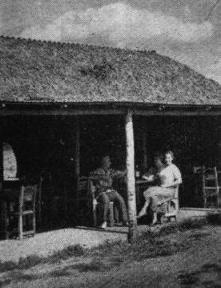 – [no caption – looks like an open rural café]
– [no caption – looks like an open rural café]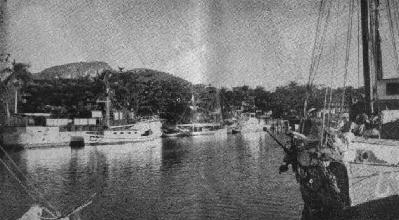 – Las Casas, River
– Las Casas, River
Getting to the isle of Pines is easy. From Havana
there is a
special train every evening for the port of Batabanó where
connections are made with the ship to Nueva Gerona, which
makes the
overnight voyage in around ten hours. Cars may be
taken over on
these steamers at a reasonable price. Aerovias Q has
two daily
flights to Nueva Gerona, the trip lasting around thirty-five
minutes. Round-trip fares are about the same: $12 for
the
train-boat trip ($15 with private cabin) and $12.95 for the
plane. Transportation from the airport to Nueva Gerona
costs
about a dolar [dollar], while passengers going to the Santa
Fe Hotel
are taken there free by the hotel's station-wagon.
All in all, a vacation on the Isle of Pines will prove, no
matter what your tastes are, a truly unforgettable
experience.
Page 18
Full page advertisement for Banana Cordial
Page 19
THE HAVANA ZOO
[To see a full size photo,
right click and VIEW IMAGE]
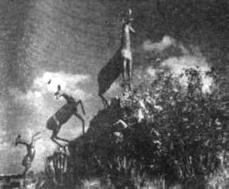 – Antelopes
– Antelopes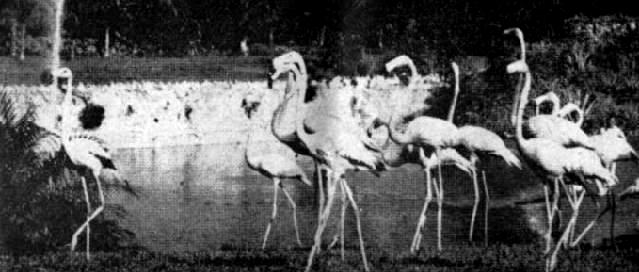 – Flamingoes
– Flamingoes
Have you ever been to our Zoo? We ask this, because
for too many
people this outing is mere distraction, apt–as the Film
Review Board
says–for children under 12. And too many of these
people sneer at
the thought of visiting the Zoo.
The first thing one notices on entering Havana's Zoological
Park, as
our zoo is called, is that this is not a classic, formal and
orderly
Zoo such as is found in Europe's old cities, or in modern
cities
anywhere with pretensions to being great metropolis.
Our Zoo is
something different, very Cuban, not at all the official
model Zoo.
Our Zoological Park has a lot of Park and little
Zoological. It
is a beautiful spot, well-tended, clean and gay, with large
and
well-cared-for gardens; with shady nooks for relaxing and
chatting;
with toys and open spaces for the children to play and have
fun
in. It is the city's breathing place, a site for
enjoyment, rest
and innocent pleasure, which in addition has some handsome
specimens of
our native fauna, as well as many interesting imported
animals.
The wild animals, of course, are foreign. But because
it is
expected of us we do have a group of lions, tigers and
bears,
children's classic preferences in wild animals, and we fill
the rest of
the Zoo with charming little Cuban animals, cute, lovable
and
sufficiently strange to the average visitor to make him feel
that each
cage contains a rare find.
Page 20
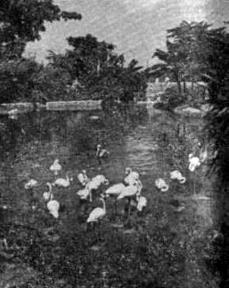 – Flamingoes [To see a full
size photo, right click and VIEW IMAGE]
Gaviria Restaurant advertisement
– Flamingoes [To see a full
size photo, right click and VIEW IMAGE]
Gaviria Restaurant advertisement
Birds of the most dazzling hues and thrilling songs are set
loose
within enormous cages which contain growing bushes and even
trees,
there to live freely, not knowing that they are imprisoned
by the
almost invisible wire mesh that surrounds their comfortable
abode.
There are the tocororo, the sinsonte, the arriero and the
exotic
hummingbird flashing among the slower flocks of parrots
parakeets and
tomeguines. Over here are the waterfowl happily
splashing and
feeding in their lagoons and winding streams: cranes and
king herons,
geese and ducks and venerable pelicans, of the species whose
name has
become known all over the U.S. in relation with another kind
of tough
bird altogether: the alcatraz.
Those rocky islets are where the simians hang out: monkeys
and apes of
all sizes and kinds have their houses–and their
trapezes–there.
There are also small meadows where our tiny Cuban deer live,
whose
fawns muzzle you searching for tit-bits or peanuts and drink
milk
eagerly from bottles brought by children not much bigger
than
themselves.
We don't have any rhinoceroses, giraffes nor hippopotami,
those African
exports so well-known and expensive, which are the pride of
large
Page 21
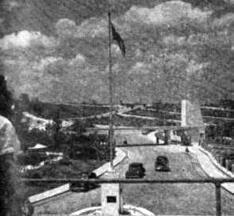 – [no caption] [To see a full
size photo, right click and VIEW IMAGE]
Matusalem Rum advertisement
– [no caption] [To see a full
size photo, right click and VIEW IMAGE]
Matusalem Rum advertisement
Zoos. Nor do we have specimens of our fine native
horses, which
we should have, nor our indigenous cattle, nor the jibaro or
wild dog
which is dying out, nor the jabali or wild boar. But
we do have
any number of jutias congas and the like.
For every Cuban, it is strongly recommended that he visit
the Zoo:
previous acquaintance is a virtual necessity against the
time when
inevitably he will have a small children clamoring to be
taken there
for picnics on Saturday afternoons and sleepy Sunday
mornings.
But for the foreign visitor who comes here to see what he
doesn't have
at home, a visit to the Havana Zoo will bring him new
sights. It
won't call to mind a warehouse, nor a museum; there are no
filled
shelves nor streets lined with cages on either side.
It is not an
old curiosity shop nor a Noah's Ark. It is a pleasant,
charming
spot where one goes for a good time rather than see
animals. It
is not a place to teach nor to learn but simply to find
distraction,
peace of mind and a quiet sun-drappled happiness.
Page 22
Bambu Club adverisement with three photos
Page 23
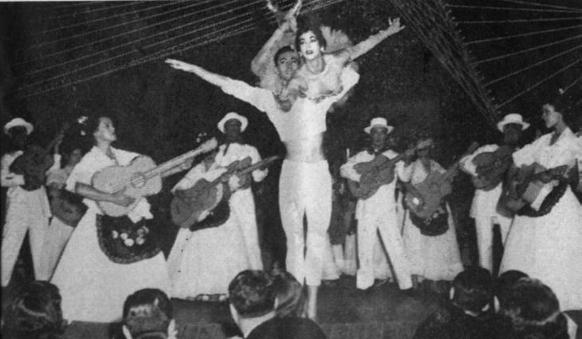
[To see a full size photo, right click and VIEW IMAGE]
– Tropicana Cabaret. ~ A scene from the production "Mexican
Fantasy", in which are seen Leonela Gonzalez and Henry Boyer
appearing
on a "ball room lift".
HAVANA BY NIGHT
"It looks as Havana is becoming a branch from Las
Vegas"...Those are
the very same words that a movie producer from Hollywood
said to us a
few days ago. Just imagine that a few years ago there
was only
one place with a gambling casino in the whole island, and up
to this
date there are seven of them including the ones at the race
tracks and
at Jai Alai game house. Along with the gambling houses
the shows
at the nightspots has been increasing with a better
spectacle, and now
days they have the luxury of "importing" singers directly
from
Hollywood and France. Today is very hard to make up
your mind
about visiting a nightspot, because you may tell to yourself
that
MONTMARTRE is presenting a top star from France, but instead
TROPICANA
is showing another top at-
Page 24
[To see a full size photo,
right click and VIEW IMAGE]
– Picture taken diring [during] rehearsal of a production at
Montmartre
PHOTO – Entrance to "Louis Candela's Cave", inside of la
"Tasca Espanola"
traction from Hollywood, and Sans Souci is showing a
marvelous crooner
from the States, etc., and it makes you feel like seeing
them all at
once.
For instance lets take a ride over to Sans Souci, and we
find that
genius Lefty Clark has on the stage beginning the 6th of
this month one
of America's best crooners, Mr. Tony Martin. Also we
had the
pleasure of seeing during the last month of February at Sans
Souci,
wonderful Dorthy [Dorothy] Dandridge who plays the role of
Carmen Jones
in the picture with same name, and also another actress from
the screen
Joanne Gilbert. All
Page 25
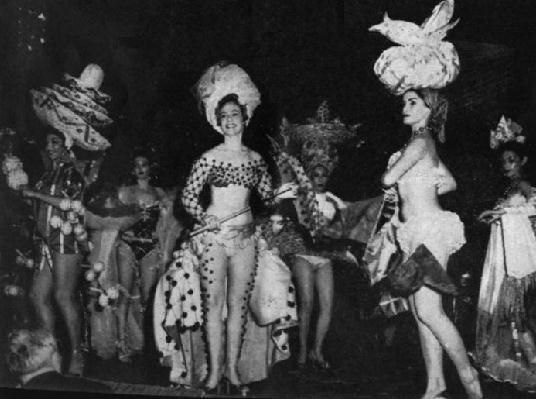
[To see a full size photo, right click and VIEW IMAGE]
– Cabaret Tropicana. ~ Nora
Osorio, Ofelia Garcia, Elizabeth,
Alicia Figueroa and Jenny, are seen dancing along with the
rythmns
[rhythms] of the French "drums".
La Zaragozana advertisement
this shows presented at the fabulous nightspot have been
possible by
the management of Mr. Clark, whom since took over this
rustic cabaret
is delighting the crowd with the best of shows.
TROPICANA, well known all over the world as the "Paradise
under the
Stars", is presenting on the stage the "hit singer" of the
moment, the
men that made of Tenderly's recording sell like "hot
bread. Mr.
Nat (King) Cole. This is one of the many attraction
that Cuban's
producer Mr. Rodney has in mind in his 230,000 dollars
show.
Another of TROPICANA surprise is the showing on the stage of
Mr. Rythmn
[Rhythm]... Billy Daniels; whom will appear the 16th of this
month in
both Rodney produc-
Page 26
[To see a full size photo,
right click and VIEW IMAGE]
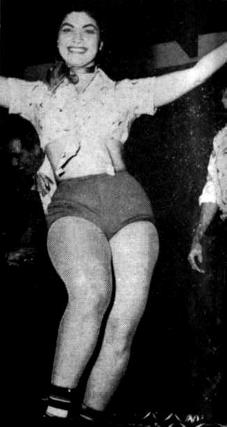 – Mary, dancing partner of Renny at Bambu
– Mary, dancing partner of Renny at Bambu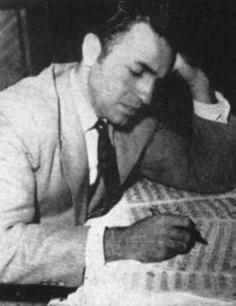 Lucio Iandoli, producer at
Bambu
Lucio Iandoli, producer at
Bambu
Morro 60 Rent-A-Car advertisement
tions "Mexican Fantasy" and "Tropic Nights". Both of
this
productions formed by a group of sixty dancers and Chorous
[chorus]
singers have the figures [continues on page 30]
Page 27
Miami Restaurant advertisement
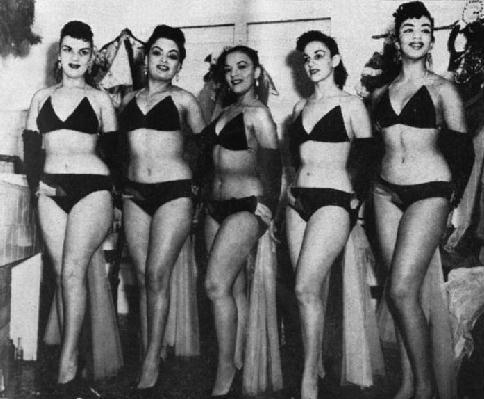
[To see a full size photo, right click and VIEW IMAGE]
– Night and Day Cabaret. ~ If our readers were doubling
the
existence of these "superchickens", here you have a small
sample.
From left to right: Mary, Marta Guille, Nenita and Aida.
Page 28
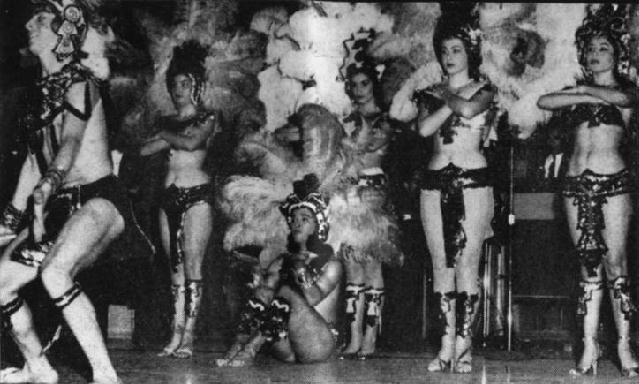 [To see a full
size photo, right click and VIEW IMAGE]
PHOTO – Cobaret [Cabaret] Tropicana. ~ The production
named "Mexican
Fantasy", has received the unanimous approval from the
most demanding
newspaper criticiser [criticizer], since the day of its
debut.
Here is one of the many scene, in which our reader may
judge the
magnificence of the wardrobe.
[To see a full
size photo, right click and VIEW IMAGE]
PHOTO – Cobaret [Cabaret] Tropicana. ~ The production
named "Mexican
Fantasy", has received the unanimous approval from the
most demanding
newspaper criticiser [criticizer], since the day of its
debut.
Here is one of the many scene, in which our reader may
judge the
magnificence of the wardrobe.
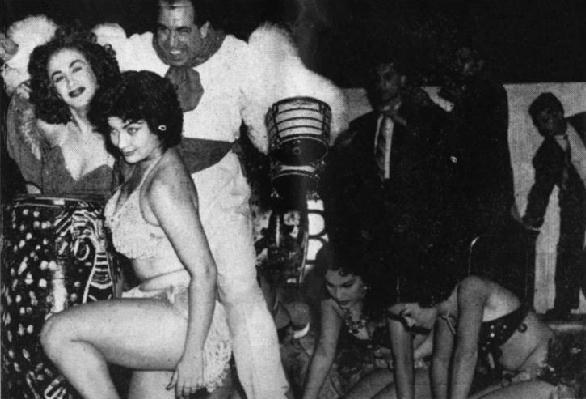 – In one scene the
production "Tambo" at BAMBU, are seen Mary, Olga Gonzalez
and Manteca.
Page 29
– In one scene the
production "Tambo" at BAMBU, are seen Mary, Olga Gonzalez
and Manteca.
Page 29
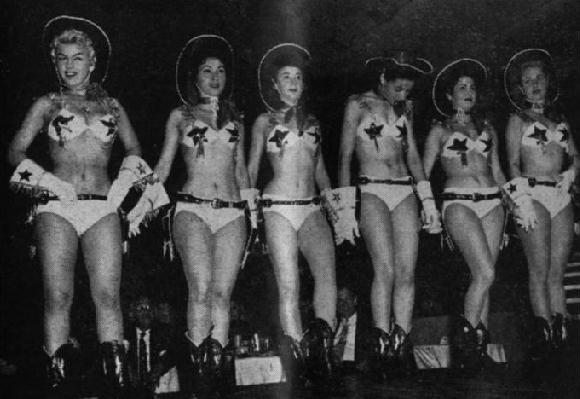 [To see a full
size photo, right click and VIEW IMAGE]
-- During the "trip" of production "Carlyle Around the
World", we
are now right in the middle of the west in Oklahoma, and
how safe we
feel with these cowgirls well armed. From left to
right Elenita
Samanich, Gladys Ziscay, Nelsy Vega, Maria, Maribel and
Maria Eugenia
[To see a full
size photo, right click and VIEW IMAGE]
-- During the "trip" of production "Carlyle Around the
World", we
are now right in the middle of the west in Oklahoma, and
how safe we
feel with these cowgirls well armed. From left to
right Elenita
Samanich, Gladys Ziscay, Nelsy Vega, Maria, Maribel and
Maria Eugenia
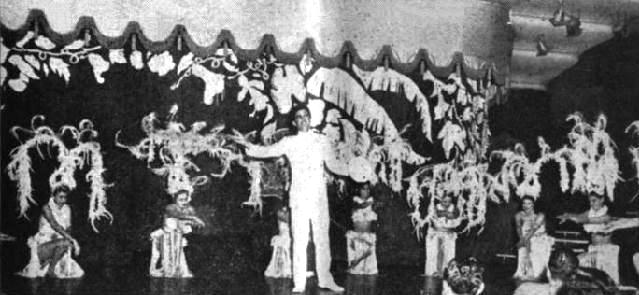
– Below. ~ Another scene of the Production at MONTMRTRE
Page 30
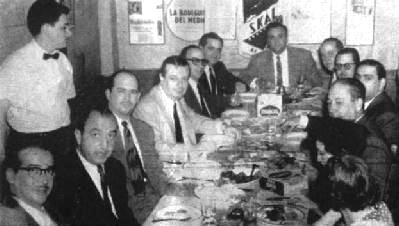
[To see a full size photo, right click and VIEW IMAGE]
– SKAL. Members were celebrating at the BODEGUITA DEL
MEDIO.
There isn't a better place in the city with the best of
our typical
Cuban food.
La Bodeguita del Medio advertisement
[text continued from page 26]
of Cuba's best mambo dancing couple Ana Gloria and Rolando,
whom for
their dancing quality have maintain themselves through all
Rodney's
productions. Some others Stars at the show are D'Aida
Quartet,
Leonela Gonzalez, Xiomara Alfaro, etc. This montecarlo
of the
America keeps its shape into the best of shows.
At MONTMARTRE, producer Carlyle is given the best off his
little cute
head when presenting on the stage the production titled
"Around the
World". The crowd at the only listening of the
production's name
has taken over this nightspot every single night since its
debut the
15th of January. Carlyle now announce for the 15th of
April the
great French man Maurice Chevalieur, and for the coming 4th
of May
wonderful songstress Jacqueline Francois, another of
Page 31
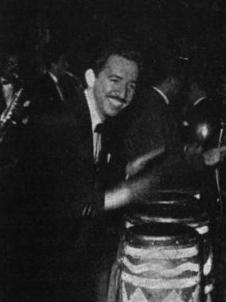 [To see a full size
photo, right click and VIEW IMAGE]
– Dario. Rrums [drums] player at Tropicana.
[To see a full size
photo, right click and VIEW IMAGE]
– Dario. Rrums [drums] player at Tropicana.
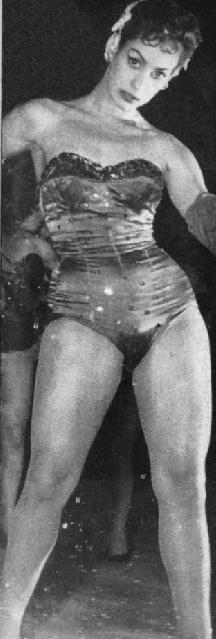
– Sonia Calero. Star in the production at Sans Souci.
France top attraction in this little French corner of the
America. At the production beautiful Chorous [chorus]
girls
Gladys Ziscay, Nelsy Vega, Maria, Maribel, Maria Eugenia,
and many
others that will help you spend a nice evening.
BAMBU, rustic nightspot at Rancho Boyers [Boyeros] Highway,
presents
Italian producer Lucio Iandoli with one of his best
production–"Tambo"
which has gathered many of Cuban best dancers, singers and
now the
voice of Italian singer Miguel Angel Verso. Also on
the stage the
typical dancing couple Mary-Renny, Cuban vedette Mary
Esquivel, popular
drums player
Page 32
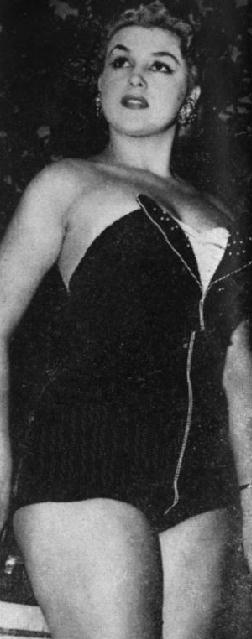
[To see a full size photo, right click and VIEW IMAGE]
– Otelia de Armas. Chorous [chorus] girl at MONTMARTRE.
Castillo de Jagua advertisement
"Manteca", and a cast of thirty Cuban beauties.
Hector del Villar at beautiful NIGHT AND DAY, has just
finished setting
up two wonderful production titled "Blue Brick" and "The
Moon on
Waikiki". The heading cast of both productions are
Cuban
"guaracha" singer Juana Bacallao, Sonia Saavedra and Rudy,
and singer
and master of Ceremonies Mexican Victor Manuel. This
is another
nightspot on Rancho Boyeros Highway.
LAS VEGAS is one of the many nightspots that has begun the
year with a
stage show. This enchanting cabaret on the Vedado
section
presents every so often different singers dancers of our
very best from
TV and Radio, at the Blue Room
PENNSYLVANIA and PANCHIN presents wonderful shows every
night.
These two magnificent cabarets are located on the way to
Marianao
Beach. Another nightspot near by Rancho Boyeros
highway is
TOPEKA, with an splendid floor show.
Page 33
[To see a full size photo,
right click and VIEW IMAGE]
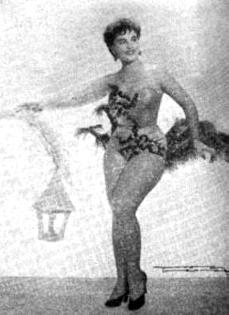 – Minet Cedan.
– Minet Cedan. – Rosa Blanco. Chorous
[chorus] girl.
– Rosa Blanco. Chorous
[chorus] girl.
CASINO PARISIEN, the newly opened nightspot at the National
Hotel,
presents on the stage the CBS recording star Felicia
Sanders, whom now
amuses the crowd with her delightful voice.
As you see, my dear traveler, coming to Havana this season
and seeing
the shows will make your trip a worth while one. And
when it
comes to dine out, don't forger that there are many places
serving food
in every styles: French, American Italian, Spanish, Cuban,
etc. such
as: TWENTY ONE CLUB, MONSEIGNEUR, SORRENTO, GAVIDIA,
SARAGOZANA, MES
AMIS, BODEGUITA DEL MEDIO, WILLIES, FLORIDITA, PALACIO DE
CRYSTAL, etc.
Well my good friend I have to leave you now wishing you that
your staying in Havana will be a delightful one. So
long.
Page 34
HUMOR
Page 35
TOURIST
SUPPLEMENT
PASSPORTS. U.S. and Canadian citizens do not need
passports to
enter Cuba as tourists, but they must have bonafide
documentary
evidence which will prove to the transportation companies
that they are
citizens of those countries. Visitors from other
countries must
comply with passport regulations. French and Swiss
citizens are
exempt from the visa requirement and British subjects
holding U.K. and
Northern Ireland passports may also enter Cuba without
visas.
TOURIST CARD. The Tourist Card which visitors to Cuba
receive
from the transportation companies, or when they arrive in
Cuba, costs
$2.50, and is valid for two years. This Card should be
saved as
no duplicates are issued.
CUBAN CUSTOMS REGULATIONS. Tourist are permitted free
entry of
regular baggage, including automobiles, trailers, amateur
photo and
movie cameras, portable radios and typewriters, 400
cigarettes, fishing
equipment and guns (not rifles) for hunting purposes.
DRIVING IN CUBA. Tourists are authorized to drive
automobiles in
Cuba, provided they possess for this purpose legal
authorization from
their country of origin, which they are obliged to present
to the Cuban
authorities when requested to do so.
AUTOMOBILES FOR SELF-DRIVING. Automobiles are
available in Havana for drive-yourself rental.
TOURIST SERVICES IN HAVANA
TOURIST POLICE SECTION.
The
National Police Department has a "Tourist Section" dedicated
to the
attention and protection of our visitors. Its members
can be
easily distinguished by the arm badge marked: "National
Police Dept.
Tourist Division".
GUIDES. There
is a
well organized corps of authorized English-speaking Guides
whose
service can be obtained at a reasonable rate, either by
arrangement
with the hotel management or through the offices of the
Cuban Tourist
Institute. Both service and fees are officially
regulated.
Be sure to see the Guide's license and badge.
INFORMATION.
The
Cuban Tourist Institute has an office, located at Carcel No.
109, near
Prado Blvd., Havana, where, without charge of any kind, the
visitor
will be given all the information he may desire: and, should
he wish,
itineraries for excursions through the interior of the
country will
also be gladly prepared. The Cuban Tourist Institute
also has an
Information Office in Miami at 336 E. Flagler Street.
MAIL
The postage rate for Aid Mail service between Cuba and the
United
States of America, its possessions and Canada is 12 cents
for the first
½ oz. Or fraction thereof, and 12 cents for each additional
half
ounce. Regular Mail: 4 cents for each ounce or
fraction thereof
and 3 cents for post cards.
HAVANA PROVINCE
Although this is the smallest province of the Island it has
a
population of 1,544,000, of which over 800,000 are
inhabitants of
Havana, Capital of the Island. The Isle of Pines forms
part of
this province.
The City of Havana is particularly attractive to visitors
because in
the course of its four hundred-odd years of existence it has
acquired
the customs and activities of a gay, modern cosmopolitan
city through
its contacts with European and American countries–reflected
in the
splendid boulevards, gardens, parks and the magnificent
buildings of
ultra-modern architecture-while it has yet retained all the
interesting
aspects and charms of colonial times found in the primitive
city where
the narrow streets, cozy little plazas, forts, ancient
churches and
many others places of interest are located.
PRINCIPAL POINTS OF
INTEREST IN AND AROUND HAVANA
MORRO CASTLE. Famous fortress guarding the harbor of
Havana; its
construction was commenced in 1589 and finished in
1597. Because
of its interesting and often
Page 36
PHOTO – [no caption - possibly Maine Monument]
exciting relics of its past, it is well worth the launch
trip across the harbor.
LA CABANA FORTRESS. This fortress, which extends
beyond the
Morro, cost $14,000,000. Its construction began in
1765 and
finished in 1774; it was, at that time, considered
impregnable.
Today, however it has merely a historical value and is used
as a
prison. From this fortress a blank cannon shot is
fired at nine
every night according to an ancient tradition.
LA PUNTA FORTRESS. At the Prado. Built in 1598
to
supplement the Morro Castle in the defense of Havana.
It guards
the entrance to the harbor.
LA FUERZA CASTLE. Second oldest fortress in the New
World, the
construction of which was commenced in 1538 and finished
about the year
1544. From its tower De Soto's wife, Isabel de
Bobadilla, scanned
the horizon daily for a sight of her husband's ships which
never
returned from the discovery of Florida.
ATARES CASTLE. Built in the 18th century. The
obelisk on
the side of the hill commemorates the execution of the young
Kentuckian
Col. William Crittended and 50 companions who had come with
an
expedition under General Narciso Lopez, to fight for Cuba's
liberty.
SAN LAZARO TOWER. (Torreón) Small tower on the Malecón
near Maceo Park which in Spanish colonial days was very
important as a
lookout for pirates.
PRINCIPE CASTLE. The broad sweep of the Ave. of
Independence
(Carlos III) leads to the foot of a hill, crowned by the
imposing
Castle of the Prince, today the jail. In the
cross-section of the
surrounding cliffs, are the tunnels which in the times of
Spain served
as a secret passageway.
CATHEDRAL SQUARE. This has been recently restored to its
original
glory. The venerable cathedral is faced by colonial
mansions once
housing the nobility of Cuba.
COLUMBUS CATHEDRAL. Ancient structure whose external
rugged
grandeur conceals a wealth of beautiful vestments and old
silver.
The body of Columbus was interred here for many years.
PLAZA DE ARMAS. Ancient square on which "The
Templete", "La
Fuerza Castle", the "Lieutenant Governor's Palace", and the
"City
Hall", described below, are located.
THE TEMPLETE. On the very spot where the first mass
was celebrated in Havana, under the shade of a great Ceiba
tree.
CITY HALL. With its magnificent and ancient colonial
patio, it
was once the home of the Spanish Governor-General of the
Island.
SAN FRANCISCO CONVENT. This massive edifice, exponent
of the
austere Spanish style of the XVI century, devoid of fantasy,
seems to
be inspired by the dual spirit of realism and
mysticism. The Post
Office Department now occupies these premises which have not
lost their
conventual atmosphere.
SECTION OF OLD CITY WALL. Opposite Presidential
Palace.
Formerly, Havana was completely surrounded by an old wall
locking
Havana in after the nine o'clock curfew. A section
facing the
Presidential Palace has been carefully preserved as a relic
of the
past. (The cannon shot is still fired at 9:00 p.m.)
PRESIDENTIAL PALACE. A handsome and modern structure
combining
various architectural styles. The commanding feature
of this
palace is glass-tiled dome dominating the neighborhood.
MALECON DRIVE. This beautiful drive is separated from
the open sea only by the heavy stone wall which gives it is
name.
STUDENTS' MEMORIAL. This monument is at the end of the
Prado, and
commemorates the unjust execution of eight medical students
in 1871 by
Spanish volunteers.
NATIONAL AMPHITHEATRE. On Port Avenue. A
magnificent marble
structure where, under tropical skies, beautiful public band
concerts
are held frequently.
PARQUE MACEO. Beautiful park honoring the great
patriot Maceo who
is immortalized by an equestrian statue in the center of the
park.
FRONTON JAI-ALAI. At Concordia 556. Games are
held at this "fronton" every evening except on Mondays and
Fridays.
FRONTON HABANA-MADRID. At Belascoain 903. Games
are held every after-
page 37
PHOTO – [looks like Paseo de Marti]
noon at 3:00 p.m. and Mondays & Fridays at 9:00 p.m.
MAINE MONUMENT. Cuba's handsome memorial in honor of
the heroes
of the U.S.S. Maine located on the Malecon Drive. The
cannons and
chains on the monument were salvaged from the decks of the
ill-fated
battleship.
CAPITOL. This majestic palace has no equal as to
grandeur or
luxury in Latin America. Costing 28 million dollars,
the Capitol
impresses visitors with its sumptuous decorations, its noble
proportions, and rich materials: marble, stone, gilt, bronze
and
precious woods.
PARQUE CENTRAL. Flanked by the famous open-air cafes
where the
orchestras rival each other in feminine pulchritude and in
the quality
of their rumba music, Central Park is the starting point for
our
nightlife and the customary promenade down the Prado.
In the
center of the park is the statue of Jose Marti, the apostle
of Cuban
Liberty.
CENTRO ASTURIANO. Medical aid and cultural society
with a
membership of about 70,000. A beautiful ball room, all
marble
stairs and famous tiled bar are the architectural
high-lights of this
building with so much social significance.
NATIONAL THEATRE AND CENTRO GALLEGO. In this beautiful
opera
house the world's greatest singers have appeared. The
Centro
Gallego is another medical aid and cultural society similar
to the
Centro Asturiano.
ZOOLOGICAL GARDEN. Located on 26th Street at Carretera
de Aldecoa, Alturas del Vedado.
SPORTS PALACE. This magnificent building is the scene
of very
good boxing matches & other interesting sports
events.
Located at the foot of Paseo Blvd., Vedado.
COLON CEMETERY. Twenty-third Street leads to this
Cemetery.
Millions have been spent here in marble mausoleums, tombs
and general
decorations.
PAN-AMERICAN FRATERNITY TREE AND PARK. Planted in
Fraternity Park
in 1928 at time of the Sixth Pan-American Conference held in
Havana,
this tree symbolized the fraternal affection of the
Americas, springing
as it does from soil gathered from the 21 American
countries.
PASEO DE MARTI. (THE PRADO) This sumptuous and historic
avenue, called
the Champs Elysees of Havana, extends from Fraternity Park
to the water
front.
UNIVERSITY OF HAVANA. This University was founded 210
years ago,
and its modern buildings, thousands of students and
collaborating
faculty uphold the tradition of excellence which it has held
since its
foundation. Annexed to the University is the Calixto
Garcia
Hospital.
QUINTA DE LOS MOLINOS. The University Botanical Garden
is today
an interesting tropical garden but was formerly the Country
Residence
of the Spanish Governors and was mentioned in "Anthony
Adverse".
GRAN STADIUM OF HAVANA. Where Professional and Amateur
Base Ball Championships are held every year.
MAXIMO GOMEZ MONUMENT. On Avenida de las
Misiones.
USEFUL ADDRESSES AND
TELEPHONE NUMBERS
American Embassy Calzada & M Sts.,
Vedado FO-3151
Anglo-American Welfare 9 San Juan de Dios St.
M-2654
Anglo-American Community Hosp. 352 2nd St.,
Vedado F-6651
British Embassy Edificio Bolivar, Carcel &
Morro Sts. A-2905
Canadian Embassy Ambar Motors Bldg., Infanta
& 23rd UO-9457
Cuban Tourist Institute 109 Carcel
St. ML-1670
Haitian Legation 68 20th Ave., Miramar
B-8377
Mexican Consulate 156 19th St.,
Vedado F-3903
National Police Headquarters Chacon and Cuba
St. M-7100
Tourist Police Department 420 Oficios St.
M-8339
Venezuelan Consulate Monserrate & Empedrado Sts.
M-8002
Spanish Embassy 161 7th St., Vedado
FO-1637
Page 38
La Zaragozana advertisement
HOTELS
ALAMAC, Galiano 308
AMBOS MUNDOS, Obispo 153
ARECES, Prado 106
ATLANTIC. 1ST Ave., Miramar
BIARRITZ, Prado 519
BRISTOL, Amistad 305
BRUZON, Bruzon 217
CARABANCHEL, O'Reilly 360
CARIBBEAN, San Ignacio and Chacon
COLINA. Land 27th Sts., Vedado
COMODORO, 72 and Mar, Miramar
CUANDA'S CLUB. Guanabo
GRAN AMERICA, Industria 502
GRAN HOTEL, Ave. Brasil 557
INGLATERRA, Prado 416
LINCOLN, Galiano 164
MONTSERRAT, Ave., Belgica 401
NACIONAL DE CUBA, 21 and O. Vedado
NUEVA ISLA, Monte 259
OCEAN, Malecon 69
PACKARD, Prado 51
PARKVIEW, Colon 101
PERLA DE CUBA Amistad 548
PLAZA, Central Park
PRESIDENTE, Calzada and G. Vedado
PUERTO PRINCIPE, Playa Cuba, Guanabo.
PUERTO ANTONIO, Guanabo
REGINA, Industria 410
RITZ, Neptuno 514
REGIS, Prado and Colon
ROYAL PALM, Industria 354
SAN CARLOS, Ave. Belgica 507
SAN LUIS, Belascoain 73
SEVILLA-BILTMORE, Prado 255
SIBONEY, Prado 355
SURF, Malecon 31
TOLEDO, 25 No. 202 Vedado
TROTCHA, Calzada 758, Vedado
VEDADO, O. entre 23 y 25
VICTORIA, 19 No. 191 Vedado
APARTMENT HOTEl, 8 and 19 Vedado
RESTAURANTS
ARBOLEDA, National Hotel. O & 21st Sts., Vedado
AMERICA, 269 Italia Avenue.
BAHIA. 56 Puerto Avenue
CARMELO, 515 Calzada Avenue, Vedado
CARMELO, 23rd St. between G & H Sts., Vedado
CASTILLO DE JAGUA, 23rd and G Sts., Vedado
CHEZ MERITO, President's & Calzada Avenues, Vedado
CLUB 21. 21ST and O Streets, Vedado.
THE COLONY. 102 21ST Street, Vedado.
LAS CULEBRINAS. 1263 Calzada Ave., Vedado
EL BATURRO, 661 Egido St.
EL FARO DE SAGUA, 602 F. St., Vedado.
FLORIDITA, 557 Obispo St.
GAVIRIA, 101 Calzada St., Vedado
HONG KONG, 23rd and 26th Sts., Vedado
MIAMI, Prado & Neptuno Sts.
MAR Y TIERRA, 65 Padre Varela St.
MONSEIGNEUR 21 and O
MES AMIS, 7 and 12, Miramar
PALERMO, 252 Amistad St.
PARIS, Cathedral Square
PRADO 86. 264 Prado Boulevard
PUERTO DE SAGUA, 415 Acosta St.
RADIOCENTRO, 23rd & L. Streets, Vedado
SEVILLA, Sevilla Biltmore Hotel
TALLY-HO, 23rd & L Streets, Vedado
LA REGULADORA, 412 Amistad St.
SIGLO XX, 251 Padre Varela & Neptuno Sts.
EL TEMPLETE. 1 Narciso Lopez St.
TERRAZA, 001 17 St., Vedado
VIENES, 402 K Street, Vedado
VEDADO HOTEL, O between 23rd Sts., Vedado
WILLIE'S BAR, (Restaurant) 21 St and N Sts., Vedado
LA ZARAGOZANA, 355 Belgica Avenue
CASA SUAREZ, 10 San Lazaro St.
SORRENTO, Calzada & 20, Vedado
PULLMAN RESTAURANT, 312 Consulado Street
EL PACIFICO, San Nicolas & Zanja Sts.
EL PALACIO DE CRISTAL, San Jose 114
NANKING RESTAURANT, 3 Virtudes St.
LA CONCHA, Marianao Beach
RIO RITA, Guanabo Road
MR. LUCKY, Via Blanca
RIO CRISTAL, Rancho Boyeros Road
SAIGON CLUB, 5th Ave & 44, Miramar
TERRAZA CLUB, Cojimar Road
TOPEKA CLUB, Rancho Boyeros Road.
Page 39
WHERE TO SHOP
EL ENCANTO. (Galiano & San Rafael Sts.) Havana's
largest
department store, the accent hare is on quality. Their
French
Salon handles dresses by Dior, and the perfume counter has
what is
probably the largest stock of perfumes in Cuba.
HERMAN'S STORE. (Prado 256, opposite the
Sevilla-Biltmore).
For twenty-five years, Herman's has been a Mecca for
tourists.
FIN DE SIGLO. (San Rafael & Aguila Sts.) Another
large
department store dealing in quality merchandise, you might
say it plays
Saks To El Encanto's Bonwit Teller, or viceversa.
FUSTE SHOP (208 Amistad St.) Heard our Cuban music?
Like
it? Want to take some back to play for the folks back
home?
Well, here's the place to get your records.
EATING OUT IN HAVANA
CLUB 21 (N & 21st., Vedado) Specializes in seafood and
American beef.
MIAMI (Corner of Prado & Neptuno) Spanish, American and
Cuban cooking; every kind of local fruit can be bought here.
PALACIO DE CRISTAL (Corner of San Jose & Consulado Sts.,
across the
way from the Capitol) Recently decorated, or rather,
rebuilt.
International cuisine.
FLORIDITA International CUISINE. Cradle of the frozen
Daiquiri
CASTILLO DE JAGUA (23rd St. & Avenida de los
Presidentes, Vedado)
Like rice? Like seafood? Like them both?
Here's an
ideal spot to go to try out two classical dishes: paella
valenciana,
and arroz con mariscos. You won't regret it.
EL BATURRO (651 Egido St.) If you've ever wanted to
eat real
Spanish food in a real Spanish tavern, this is the place to
do it.
RANCHO LUNA (Km. 1, Torrens Highway). This Cuban farm
offers
various attractions to the tourist, such as cock-fights; but
the local
set consider it a fine place to eat typical Cuban food.
EL CARMELO. (Calzada & D Sts., Vedado) For years
this had
been an institution among Havana society. The cooking
is
exceptional, and the menu one of the most varied in town, as
is the
wine cellar.
LA ZARAGOZANA, (355 Monserrate St.) One of the oldest
of Havana's
restaurants. One of the best places in town to get
seafood; the
service here is also exceptionally good.
GAVIRIA. (Calzada & M Sts., across from the U.S.
Embassy) One
of the newest and at the same time most popular spots in
town.
Page 40
UNITED STATES CUSTOMS
EXEMPTIONS FOR VISITORS TO CUBA, RETURNING TO THEIR
COUNTRY
According to the regulations of the United States
Government, each
returning resident of that country may take back with him on
his return
from Cuba, free of import duty and revenue tax, 200 dollars
worth of
merchandise purchased abroad, for personal use and
consumption, or as
gifts provided he has been absent from the territory of the
United
States at lest 48 hours, but less than 12 days, and has not
taken
advantage of this exemption within a period of 30 days from
the last
exemption claimed. In addition, residents who have
been away for
more than 12 days, are permitted to take back 300 dollar
more in value
of merchandise (excluding distilled spirits, wines, malt
liquors and
cigars, which may be included in the 200-dollar exemption),
under the
same conditions. This additional exemption shall only
apply if
the resident has not taken advantage of it within the six
month period
immediately preceding his return to the United States.
It is advisable to obtain a signed receipt whenever
merchandise is
purchased, stating the name of the articles and the prices
paid for
them, which must be presented to the Customs Inspector on
return to the
United States.
Cigars. Only 100 cigars may be included in the above
exemption.
Perfumes. Returning residents can apply the entire
amount of
their exemption to the purchase of perfumes, but in the case
of certain
brands restricted by Section 526 of the U.S. Tariff Act,
they should
consult the storekeeper or the Cuban Tourist Commission, who
will
supply the information desired in regard to these brands.
Liquor. Returning residents are allowed to take back
as part of
their exemption only an aggregate of one gallon of liquor (a
gallon is
equal to 23 cubic inches, which is four quarters or five.
4-5th
bottles), although the total of one gallon may be made up of
various
kinds of liquors.
CUBA'S VARADERO BEACH THE
RIVIERA OF AMERICA
Varadero has long been considered one of the finest beaches
in this
Continent because of its size, the color of the sea that has
won it the
title of "Rhapsody in Blue" give to it by American writer,
its soft
white sand that looks like powdered silver, the mildness of
its climate
and the incomparable beauty of its scenery. At
all seasons
of the year this beach is the meeting place of fashionable,
cosmopolitan world.
Sports: Swimming, fishing, yachting, bowling, riding,
tennis,
etc. Temperature: Summer average: 79° F; Winter
71°F.
Page 41
NIGHT CLUBS
There are a number of high class cabarets and night clubs in
Havana and
its suburbs that offer excellent shows with international
stars and
typical native music played by the best orchestras in town,
to the
delight of the dancers who crowd the floor. Some of
them are
given below:
TROPICANA. First class, open-air night club, located
on Avenida
Trephine, Buenavista suburb. Excellent music and
entertainment. Two shows nightly. Clubroom.
MONTMARTRE. Luxurious Night Club, situated on 23rd
Street, Vedado. Magnificent, shows and orchestra. Club
room.
BAMBU CLUB. Rancho Boyeros Road. Typical Cuban
music and shows.
JOHNNY'S DREAM CLUB. La Puntilla, Miramar.
EMBASSY. 23 and 26, Vedado.
PALERMO CLUB. Amistad & San Miguel Sts.,
Havana. Air Conditioned. Good dancing music.
MAXIM'S. 3 & 10 Sts., Vedado.
Orchestra. Air Conditioned.
JOHNNY'S 88. 208 O. St., Vedado. Air Conditioned
with dancing music.
MULGOBA. Rancho Boyeros Road. Typical night
club. Good music.
TOPEKA. Rancho Boyeros Road. Good music and
shows.
CLUB 21. 21st and N. Vedado. Music, exotic
decor.
TONY'S CLUB. In the heart of Havana, behind the
Capitol.
BOULEVARD ROOM. 1st and 54th, Miramar. Right by
the sea; music.
PALETE. Central Highway. 2 shows nightly.
Dancing.
EL COLMAO. Aramburu and San Rafael, Havana.
Typical Spanish atmosphere
ISLES OF PINES
Havana is the gateway to a country overflowing with tourist
attractions. Before taking our visitors through it,
however, we
wish to invite them to see the small Isle of Pines, called
"Treasure
Island" because it is believed that Stevenson used it as the
locale for
his immortal novel. It is qualified as small only in
comparison
with the larger island of Cuba, but it is 1180 square miles,
equivalent, for example, to double the island of Guadalupe,
three times
that of Martinique and capable of containing the celebrated
island of
Malta twelve times. It was discovered by Christopher
Columbus
himself, in 1493, who named it "The Isle of the
Evangelist". It
is 76 miles from the southern coast, in an extraordinarily
peaceful sea
of marvelous colors, and can be reached by boat, and also by
daily
airplane, in 35 minutes.
The medicinal springs in the Isle of Pines enjoy wide
reputation for
the excellent cures these waters have effected, especially
the springs
of Santa Rita, in the town of Santa Fe, where there is a
good hotel,
American style, the "Santa Fe Hotel", with the medicinal
springs at its
door.
PINAR DEL RIO PROVINCE
Bounded on the east by Havana Province, Pinar del Rio
occupies the
extreme western end of the Island and has a population of
454,900
inhabitants of which about one fourth reside in its capital
that bears
the same name. Through this province, where the
greatest number
of natural beauties in the country are to be found, will
pass, in the
near future, a section of the Atlantic Caribbean Branch of
the Pan
American Highway which will considerably shorten the
distance between
the United States and Central America. From one of the
ports in
the province a super ferry will leave for the Peninsula of
Yucatán, which will be joined to the Pan-American Highway by
a
road leading to San Cristobal, Mexico, near the frontier of
Guatemala.
The City of Pinar del Rio, capital of the province, is 109
miles from
Havana to which it is linked by the Central Highway and by
railroad,
passing through incomparably beautiful scenes and
picturesque
towns. It is the hub from which excursions are made to
different
points of exceptional attraction in the surrounding country.
MATANZAS PROVINCE
This Province, adjacent to that of Havana, is a region
surprisingly
favored by Nature with landscapes of uncommon beauty and
facilities for
the enjoyment of sports, especially fishing. The
population of
this Province is 400,000.
MATANZAS CITY. A very pleasant and interesting trip
from Havana
is that to Bellamar Caves, the most notable in Cuba, whose
wondrous
interior has not yet been fully explored.
There is restaurant service at the caves and also a landing
field, nearby, for the use of private planes.
SAN MIGUEL DE LOS BANOS. 91.6 miles from Havana by
highway,
nestling in a picturesque region, framed by mountains; it is
one of the
most renowned Spas in this hemisphere. The excellence
of its
minero-medicinal waters has won for it the name of "Vichy of
America".
LAS VILLAS PROVINCE
This province, also known as "Santa Clara", occupies a large
area of
exceptionally fertile land, the greater part of which is
destined for
the cultivation of sugar-cane. The population numbers
1,032,800. Both the north and south coasts are dotted
with fine
natural bathing beaches of white sand, and the adjacent keys
together
with the Ocochoa, Primero and Sagua Rivers provide excellent
fishing
grounds and beds of delicious oysters for which Sagua is
noted.
The hunt is also plentiful–quail and wild pigeon in
Page 42
Raul Lujan's Tours advertisement
particular. This province contains more sugar mills
than any
other and large shipments are made through the important
sugar ports of
Cienfuegos, on the south coast, and Caibarien on the
north. The
countryside is scenic, the San Luis Valley being specially
noted for
its beauty–and healthful climate. At one of its
highest
points–Topes de Collantes–a magnificent building has been
erected for a
Sanatorium.
There are also several thermal springs in this province,
such as San
José del Lago, nestling in a picturesque dreamland setting
near
Mayajigua, a short distance from the Caibarien fishing zone
and, for a
change, the traveler should see the marvelous caves to be
found in
various sections of the province, and visit the ancient
towns of
historic interest which have lain for centuries, like
"sleeping
beauties", untouched by the progress of civilization, and
retained all
their pristine charm as, for instance, Trinidad,
Sancti-Spiritus and
others.
CAMAGÜEY PROVINCE
The province of Camagüey has a population of 625,300
inhabitants,
and occupies a large area in the central part of the Island
whose
unusually fertile pastures have made it an important
cattle-raising
center. The benign climate makes the winter season the
most
pleasant of the year. The warmer temperature of the
summer can be
avoided by going to any of the charming places in the
mountains such as
Cubitas, Najasa, etc., where delightful vacations can be
spent.
Some of the largest sugar mills in Cuba are located in this
province
and may be visited during the grinding season.
ORIENTE PROVINCE
This province occupies the extreme eastern end of the Island
and has a
population of 1,813,900, inhabitants. It has the
greatest variety
of scenic landscapes in the country and owing to its
majestic chain of
mountains has been called "The Switzerland of the Tropics".
The famous El Cobre Sanctuary, about 12 ½ miles away from
Santiago and prominently appearing among the wooded green of
the
mountains, is reached by the Central Highway. It is
dedicated to
the "Virgen de la Caridad del Cobre", Cuba's Patroness.
SANTIAGO DE CUBA.
Capital
of the province, was settled in 1513 by Don Diego de
Velazquez,
and its first Mayor was Hernán Cortés, conqueror of
Mexico. Santiago was the first metropolis of Cuba and
is today
one of the oldest cities in America. Enchanting traces
of the
colonial epoch are still to be seen: narrow, tortuous
streets requiring
steps to make their ascent, houses of seignorial and
romantic aspect,
the remains of its celebrated Morro Castle, and that subtle
atmosphere
of times long past that fascinatingly contrast with its way
of life as
a modern capital.
Page 43
Tropicana advertisement [entire page which is inside
back cover]
Page 44
[back cover]
Sans Souci Advertisement .. [with mention of Lefty
Clark, a.k.a Willie Bischorf, being new owner]
End of Page
Copyright
1998-2014 Cuban Information Archives. All Rights
Reserved.



CUBA AIRGUIDE .. [Cover] [To see a full size photo, right click and VIEW IMAGE]
[people dining]
[two chorus girls]
[drawing of men fishing]
-- [no caption -- Ship entering harbor]
[To see a full size photo, right click and VIEW IMAGE]
– Scene near Nueva Gerona
– An abandoned church on the island
– Bibijagua Beach
– [no caption – looks like an open rural café]
– Las Casas, River
– Antelopes
– Flamingoes
– Flamingoes [To see a full size photo, right click and VIEW IMAGE]
– [no caption] [To see a full size photo, right click and VIEW IMAGE]
– Mary, dancing partner of Renny at Bambu
Lucio Iandoli, producer at Bambu
[To see a full size photo, right click and VIEW IMAGE]
– In one scene the production "Tambo" at BAMBU, are seen Mary, Olga Gonzalez and Manteca.
[To see a full size photo, right click and VIEW IMAGE]
[To see a full size photo, right click and VIEW IMAGE]
– Minet Cedan.
– Rosa Blanco. Chorous [chorus] girl.









